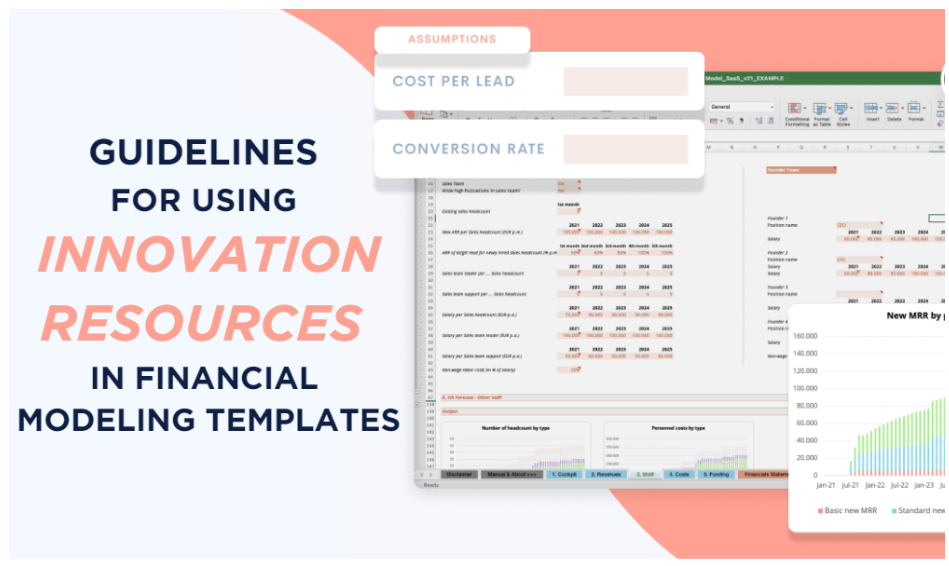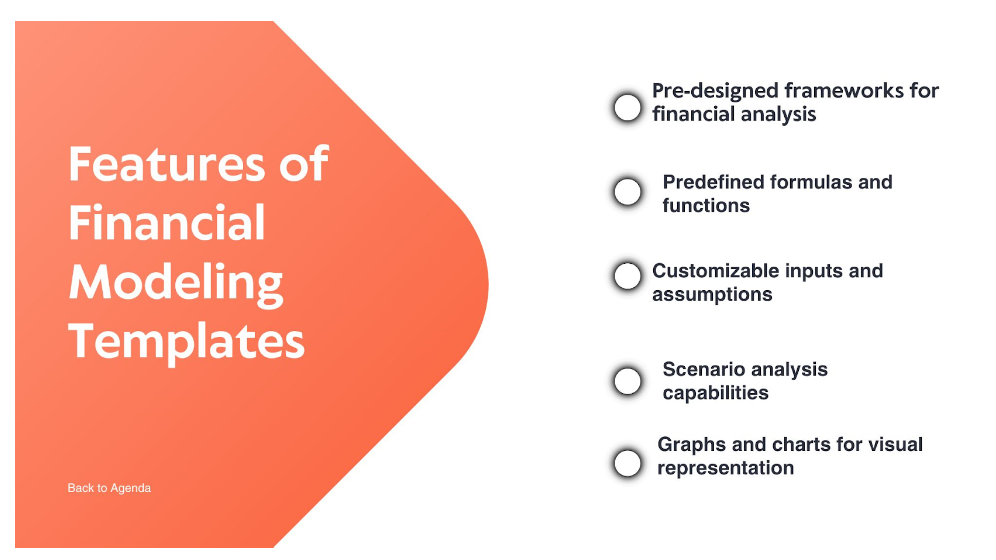In today’s rapidly evolving financial landscape, organizations and startups must stay ahead of the curve by adopting innovative tools and techniques to enhance their financial modeling capabilities.
One such powerful resource is the use of innovation resources in financial modeling templates. These resources, ranging from cutting-edge technologies to advanced methodologies, can revolutionize the way financial models are developed, analyzed, and utilized.
This blog will explore the guidelines for effectively harnessing innovation resources in financial modeling templates.
Table of Contents
Understanding Financial Modeling Templates
Financial modeling templates are pre-designed frameworks. These provide a structured approach to creating financial models. They are used in various financial analyses, such as:
- Forecasting future cash flows,
- Evaluating investment opportunities, and
- Assessing business performance.
The templates include predefined formulas, functions, and data inputs. These allow users to input their own data and customize the model to suit their specific needs. They serve as a time-saving tool. Thus providing a starting point for financial analysis and reducing the effort required to build complex models from scratch.
Features of Financial Modeling Templates
- Pre-designed frameworks for financial analysis
- Predefined formulas and functions
- Customizable inputs and assumptions
- Built-in calculations for various financial metrics
- Graphs and charts for visual representation
- Scenario analysis capabilities
- Sensitivity analysis tools
- Integration with spreadsheet software or specialized financial modeling software

Pros and Cons of Financial Modeling Templates
- Time-saving and efficiency
- Standardization and consistency
- Accessibility and widespread use
- Customization and adaptability
- Knowledge sharing and best practices
- Limited customization
- Template bias and assumptions
- Complexity for beginners
- Outdated templates
- Risk of errors
- Software compatibility issues
Understanding Types of Financial Modeling Templates
Following are a few types of financial modeling templates:
1. Balance Sheet Template
A balance sheet template provides a snapshot of a company’s financial position at a given point in time. It includes assets, liabilities, and shareholders’ equity. These templates can be created using various software, including Google Sheets. A balance sheet template in Google Sheets is a pre-designed spreadsheet that allows you to organize and present the financial information of a company’s assets, liabilities, and shareholders’ equity.
2. Income Statement Template
This template helps in projecting the revenue, expenses, and net income of a company over a specific period. It includes line items such as sales, cost of goods sold, operating expenses, and taxes.
3. Cash Flow Statement Template
This template helps in forecasting the cash inflows and outflows of a company. It tracks the sources and uses of cash, including operating activities, investing activities, and financing activities.
4. Financial Ratio Analysis Template
Financial ratio analysis templates assist in evaluating a company’s financial performance. They calculate various ratios such as liquidity ratios, profitability ratios, and leverage ratios, providing insights into the company’s financial health.
5. Business Valuation Template
These templates are used to estimate the value of a company or a specific investment. They consider factors such as earnings, growth projections, risk assessments, and industry comparables.
6. Investment Return Analysis Template
This template helps in analyzing the potential returns of an investment opportunity. It considers factors such as initial investment, and cash inflows/outflows, and calculates metrics like internal rate of return (IRR) and net present value (NPV).
Overview of Innovation Resources in Financial Modelling
Innovation resources refer to the tools, technologies, methodologies, and techniques that bring novel and creative approaches to financial modeling. They enable finance professionals to enhance the accuracy, efficiency, and effectiveness of their financial models.
Different Types of Innovation Resources for Financial Modelling Templates
- Advanced Analytics
- Automation Tools
- Cloud Computing
- Visualizations and Dashboards
- Scenario Analysis Tools
- Real-Time Data Integration
- Sensitivity Analysis
- Monte Carlo Simulation
- Collaborative Platforms
- Blockchain Technology
- Data Visualization Tools
- API Integration
Uses of Innovation Resources in Financial Modelling Templates
- Improved financial forecasting and scenario analysis
- Efficient automation of repetitive tasks and calculations
- Enhanced risk analysis and mitigation strategies
- Real-time data integration for up-to-date financial insights
- Advanced analytics for accurate prediction of financial outcomes
- Customizable templates for specific industry or business needs
- Collaborative platforms for team collaboration and feedback
- Data visualization tools for the intuitive presentation of financial information
- Streamlined modeling processes for faster decision-making
- Integration with external APIs for seamless data retrieval
- Scalable infrastructure for handling complex financial models
- Enhanced accuracy and reliability in financial projections.
Guidelines for Using Innovation Resources in Financial Modeling Templates
The following are the guidelines for using innovative resources in financial modeling templates:
1. Identify the Need
- Assess your specific financial modeling requirements and identify areas where innovation resources can add value.
- Determine the objectives, challenges, and desired outcomes of your financial modeling process.
2. Research and Explore
- Conduct thorough research on available innovation resources in the market.
- Explore different types of AI tools, technologies, and methodologies that align with your needs.
- Consider factors such as cost, compatibility, ease of use, and integration capabilities.
3. Select Appropriate Resources
- Choose innovation resources that best suit your financial modeling goals and align with your existing infrastructure and software.
- Prioritize resources that offer features like automation, real-time data integration, advanced analytics, and visualization.
4. Learn and Familiarize
- Invest time in learning how to effectively use the selected innovation resources.
- Attend training sessions, watch tutorials, and explore documentation provided by the resource providers.
- Familiarize yourself with the features, functionalities, and best practices of the chosen resources.
5. Plan and Prepare:
- Outline the financial modeling process and identify the specific areas where the innovation resources will be utilized.
- Develop a plan to integrate the resources seamlessly into your existing financial modeling templates.
- Prepare the necessary data, inputs, and assumptions required for the modeling exercise.
6. Implement and Customize
- Integrate the selected innovation resources into your financial modeling templates.
- Customize the templates to incorporate the specific features and functionalities of the resources.
- Ensure that the templates align with your desired modeling data outputs and objectives.
7. Validate and Verify:
- Test the functionality and accuracy of the innovation resources within your financial modeling templates.
- Validate the outputs against known data or manual calculations to ensure the results are reliable and accurate.
- Identify and address any errors or discrepancies that may arise during the validation process.
8. Collaborate and Seek Feedback:
- Collaborate with team members, stakeholders, or subject matter experts to gather feedback on the effectiveness of the innovation resources.
- Incorporate feedback and make necessary adjustments to optimize the utilization of the resources in your financial modeling templates.
9. Stay Updated:
- Keep abreast of the latest updates, upgrades, and advancements in the innovation resources you are using.
- Stay informed about new features, bug fixes, and best practices shared by the resource providers.
- Continuously evaluate and assess the relevance and effectiveness of the resources in your financial modeling process.
By following these guidelines, you can effectively leverage innovation resources to enhance the accuracy, efficiency, and effectiveness of your financial modeling templates.
Example of How Innovative Resources Can Be Used In Financial Modeling
Here’s an example of how an innovative resource can be used in financial modeling:
Scenario
Let’s say you are a financial analyst tasked with building a financial model to project the revenue and expenses for a new product launch over the next five years. To enhance your financial modeling process, you decide to use an innovative resource called a machine learning algorithm to predict the sales growth rate.
Step 1: Data Collection and Preparation
- Gather historical sales data for similar products or the industry as a whole.
- Collect additional relevant data such as market trends, customer demographics, and macroeconomic indicators that may impact sales.
- Clean and organize the data, ensuring consistency and accuracy.
Step 2: Implementing the Machine Learning Algorithm
- Select a suitable machine learning algorithm for sales prediction, such as a regression model or a time series model.
- Use the historical sales data as the input and the corresponding time periods as the output.
- Train the machine learning algorithm on the available data to establish patterns and relationships.
- Validate the accuracy of the trained algorithm using a portion of the historical data that was not used for training.
Step 3: Generating Sales Growth Projections
- Input the relevant data for the new product launch into the trained machine learning algorithm.
- Let the algorithm process the input data and generate sales growth rate projections for each future time period.
- Extract the projected sales growth rates from the algorithm’s output.
Step 4: Financial Modeling Integration
- Incorporate the projected sales growth rates into your financial model for revenue forecasting.
- Multiply the previous period’s sales by the projected growth rate to calculate the sales forecast for each future period.
- Apply pricing and volume assumptions to estimate the revenue generated from the projected sales figures.
Step 5: Iterative Analysis and Sensitivity Testing
- Review the financial model outputs, including revenue projections and other key financial metrics.
- Analyze the sensitivity of the model to different sales growth rate scenarios by adjusting the inputs.
- Assess the impact of varying assumptions, such as market conditions or pricing strategies, on the overall financial performance of the new product.
By utilizing an innovative resource like a machine learning algorithm, the financial modeling process can benefit from enhanced accuracy and efficiency in predicting sales growth rates. This, in turn, enables more reliable revenue projections and better-informed decision-making for the new product launch.
Final Words
Innovation resources have become indispensable in the realm of financial modeling templates. Various professionals can enhance accuracy, efficiency, and decision-making in their financial analyses. They can do so by leveraging advanced tools, technologies, and methodologies.
However, careful consideration of the pros and cons, as well as adherence to guidelines, is essential to maximize the benefits and mitigate potential drawbacks. Ultimately, embracing innovation resources empowers finance professionals. It helps them to stay at the forefront of their field and unlock new possibilities in financial modeling.













